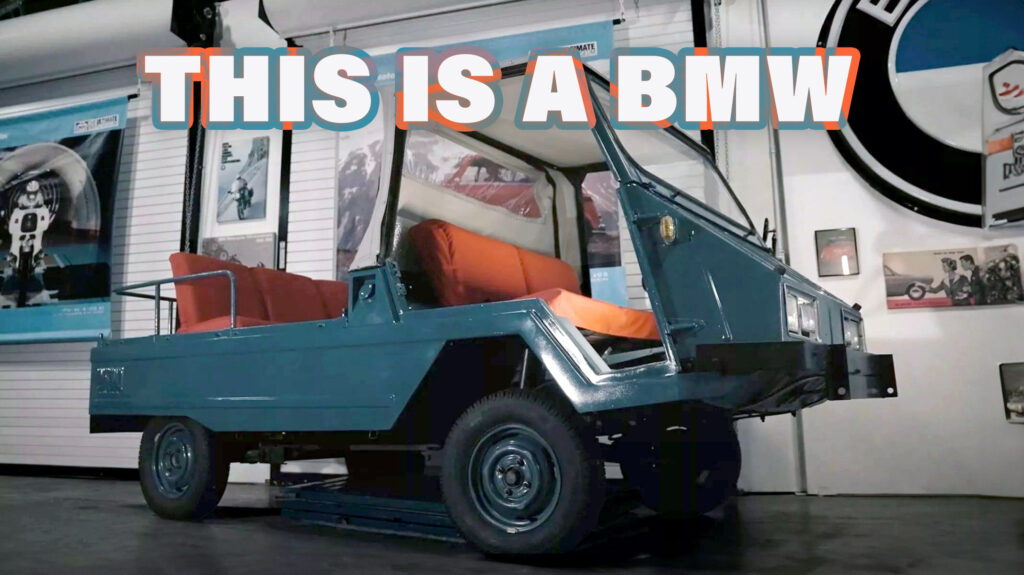During our recent trip to Spartanburg, South Carolina, for BMW‘s Test Fest, we had the opportunity to drive some incredibly interesting cars. At the same time, BMW showcased its museum and a special Motorrad exhibit commemorating 100 years of motorized two-wheelers. Interestingly, out of the 53 vehicles on display, five are cars, and we’ll explore why they’ve earned a spot in an exhibition primarily dedicated to two-wheeled travel.
As expected, their inclusion is deeply rooted in how they contributed to and shaped BMW’s storied history of success. Each car played a distinct and pivotal role, making them unique in their own right. In this feature, we dissect them all, from the Farmobil, built at a Chrysler-owned plant in Greece, to the remarkable Formula Racer.
1957 Isetta 300
Image Credit: BMW / Stephen Rivers Carscoops
Photos Stephen Rivers/Carscoops and BMW
The earliest car in the exhibit is this, the Isetta 300 from 1957. Removed just six years from when BMW restarted car production in 1951, the Isetta 300 marked a clear shift for the brand. No longer would it solely focus on its “premium only” strategy.
The Isetta allowed BMW to reach a much broader audience and it did so with a 297cc M241 single-cylinder motorcycle engine under the hood. That engine was previously used to great success in the R 25 motorcycle so BMW felt confident that it would work well in the Isetta.
More: BMW Neue Klasse Electric SUV Spied For First Time
It did just that and the company sold more than 160,000 examples between this, the Isetta 300 and the Isetta 250. This one in particular is an early fixed-window version. According to BMW, it originally made just 13 horsepower (9.69 kW) but was still capable of going up to 53 mph (85 km/h). As wild automotive experiences go, that sort of speed in this sort of microcar sounds about as batty as it gets at that speed.
1958 BMW 600
Image Credit: BMW / Stephen Rivers Carscoops
Photos Stephen Rivers/Carscoops and BMW
Buyers who liked the Isetta but needed a bit more space could turn to the 600. Of course, when new, it cost around 30% more, but it did come with more content too. For example, it had a back seat. Of course, getting there from the swinging front door would prove a challenge so it has a sliding door on the side.
In addition, there’s a semi-trailing arm rear suspension. Notably, that same general suspension setup is something that BMW used for decades after this until moving on from the design in 2004. The 600 also benefited from a larger 582cc boxer twin called the M102. It made 19.5 hp (14.5 kW) and was capped at the same 53 mph speed limit.
1964 BMW 700 Cabriolet
Image Credit: BMW / Stephen Rivers Carscoops
Photos Stephen Rivers/Carscoops and BMW
Compared to the rest of the cars in this exhibit, the 700 Cab stands out for so many reasons. First, it looks nothing like the 600 despite being differentiated by a single digit. Instead, it’s slinky, smooth, and to some eyes sexy. Dubbed the “working man’s Porsche“, the 700 Cabriolet uses a 697cc M111 boxer twin engine with just 32 hp (23 kW) and a four-speed manual transmission.
When it debuted in 1959 BMW was struggling financially and the 700 was a major success. It was so good in fact that shareholders rejected a plan for BMW to sell out to Daimler-Benz. That’s right, this little motorcycle-engine-powered car played a role in keeping BMW and Benz as separate entities. It also spurred a sedan version that only expanded the model’s success. In total, BMW built almost 190,000 units in just five years.
1965 BMW Farmobile
Image Credit: BMW / Stephen Rivers Carscoops
Photos Stephen Rivers/Carscoops and BMW
When most think of car companies that also produced farm equipment they often think of Lamborghini, Ford, or Porsche. It turns out that BMW also had a hand in the farming business, albeit briefly. This 1965 Farmobil is proof of that. It uses a 0.7-liter two-cylinder 32-hp boxer engine and a four-speed transmission as its motivating force. As an air-cooled engine, it proved incredibly robust and easy to care for.
The Kei car-sized Farmobil measures 3,350 millimeters (131.9 inches) long 1,595 millimeters (62.8 inches) wide, and 1,550 millimeters (61 inches) tall, with a wheelbase of 1,760 millimeters (69.3 inches), meaning it has a smaller footprint than a modern-day Fiat 500. It also weighed in at a featherweight 584 kilograms (1,287 pounds).
Designed by the German tractor manufacturer Fahr, the Farmobil had quite the journey. It began production in 1962 in Thessaloniki, Greece, under the ownership of a local manufacturer called FARCO, which was owned by the Kontogouris brothers. A year later, Chrysler took over the plant and renamed the company Chrysler Hellas S.A., continuing Farmobil production until it ceased in 1966.
Surprisingly, this tiny truck didn’t obtain certification for the Greek market, which led to most of its production being shipped to various countries around the world. It’s believed that only 900 units were ever produced in total, with just two currently known to exist in the USA.
While not necessarily as integral as the rest of these cars to the success of Motorrad, the Farmobil proved that BMW was widely relevant across different vehicular disciplines.
2002 Formula BMW
Image Credit: BMW / Stephen Rivers Carscoops
Photos Stephen Rivers/Carscoops and BMW
As the most extreme car in this lineup, the Formula BMW also has the biggest engine. Under the rear of the car is a 1.2-liter inline four-cylinder from the 1997 K 1200 RS. In this particular setup, it makes 140 hp at 9,000 rpm and sends that power to the rear wheels through a Hewland six-speed sequential gearbox. This is the same car that BMW used for its ADAC racing series.
That year, Nico Rosberg of future Formula 1 fame would win the series with almost 100 points more than the second-place finisher. The very next year Sebastian Vettel would take second place overall with five wins in the Formula BMW race car.
No company survives 100 years and two world wars without some major innovation in that time. These five cars are a testament to the kind of outside-the-box thinking that is required to stay alive in a competitive market. If you find yourself in the Spartanburg area, this exhibit remains on display until January 24th, 2024.










































